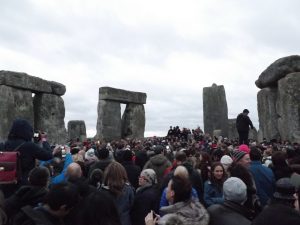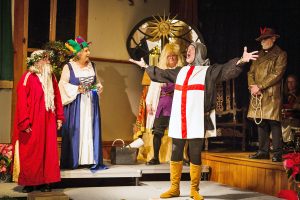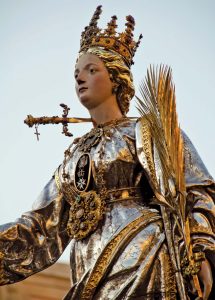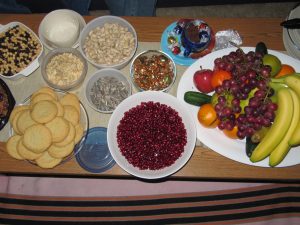By BECCA LOWRY
The winter solstice, which takes place this year on Tuesday, December 21, has been an important day for many people all over the world for thousands of years, and I can’t wait to tell you more about what makes this day so special to them.
Also called the hiemal or hibernal solstice, winter solstice occurs when either of Earth’s poles reaches its maximum tilt away from the sun. This happens twice yearly, once in each hemisphere.

People gather at England’s Stonehenge to celebrate the winter solstice.
Winter solstice is the shortest day and the longest night of the year. According to History.com, “Humans may have observed the winter solstice as early as the Neolithic period—the part of the Stone Age beginning at about 10,200 BC.” Furthermore, Neolithic monuments such as Newgrange in Ireland and Maeshowe in Scotland are aligned with sunrise on the winter solstice. Some archaeologists have theorized that these tomb-like structures served a religious purpose in which Stone Age people held rituals to capture the sun on the year’s shortest day. Additionally, Engand’s Stonehenge, which is oriented toward the winter solstice sunset, may also have been a place of December rituals for Stone Age people. I have been to Stonehenge, and it is truly a sight to behold, quite unlike anything else in the world. If you ever have the chance to go see it, I highly recommend it. On the Stonehenge Tours official website, there is a page for the Stonehenge Winter Solstice Tour, and it says that “Each year in December visitors from around the world gather at Stonehenge early in the morning to mark the winter solstice and to see the sunrise above the stones.” The cost for an adult to go on this tour is 99 euros; something to keep in mind if you’re in England during December!

DORENE SYKES
The mummers’ play has become a staple of the Solstice Singers winter performance. In this photograph, Barbara Blair (left), Lisa Jo Rudy, Wendell Bishop and Dan Hotchkiss act out a scene in the group’s 2017 “Solstice Light.”
Let’s dig into the history of how ancient cultures celebrated the winter solstice. According to History.com, the ancient Romans would hold several celebrations around the time of the winter solstice. Saturnalia, a holiday in honor of Saturn, the god of agriculture, was a weeklong celebration in the days leading up to the winter solstice. The celebration of Saturnalia was a hedonistic event in which the Romans partied all day and the normal social order turned upside down. For one month, enslaved people were even given temporary freedom and were meant to be treated as equals. Moving on to the ancient Norsemen of Scandinavia, this group celebrated Yule from the winter solstice through January. In recognition of the return of the sun, fathers and sons would bring home large logs, which became known as Yule logs. They would set one end of these logs on fire. The people would feast until the log burned out, which could take as long as 12 days. That sounds like a fun party!

Statue of St. Lucia
In more modern times, Scandinavians celebrate St. Lucia’s Day. St. Lucia was one of the earliest Christian martyrs. St. Lucia, who symbolized light, and her feast day blended naturally with solstice traditions such as lighting fires to scare away spirits during the longest, darkest night of the year. On. St. Lucia’s day, girls in Scandinavia wear white dresses with red sashes and wreaths of candles on their heads as an homage to the candles St. Lucia wore on her head to light her way as she visited imprisoned Christians, carrying forbidden food in her arms.
In China, people celebrate Dong Zhi, which means “Winter Arrives,” welcoming the return of longer days and the corresponding increase in positive energy in the year to come. In Iran, “Yalda night” is an festival that celebrates the longest and darkest night of the year. The celebration springs out of ancient Zoroastrian traditions and customs intended to protect people from evil spirits during the long night. On Shab-e Yalda, which translates to “Night of Birth,” Iranians all over the world celebrate the triumph of the sun god Mithra over darkness. According to tradition, people gather to protect each other from evil, burn fires to light their way through the darkness and perform charitable acts.

Food eaten during the Yelda night celebration
Much closer to home, on December 21, from 4:30 to 5:30 PM, you can go to the Sturgis Library at 3090 Main Street in Barnstable, where you can make your own mason jar snow globe. All materials will be provided by the library, and participants will be sent home with a hot chocolate packet and a popcorn bag. Also on December 21, the Unitarian Church of Barnstable’s women’s spirituality group will host its first meeting in two years. On this day, the women gather at one person’s house and do readings, light candles and say different words about honoring the darkness as well as the return of the sun. If you are interested in taking part in their group, call the church at 508-362-6381. The Unitarian Universalist Fellowship of Falmouth also celebrates the solstice and can be reached for details at 508-457-0449.
I also spoke with Terre Seeley, who is a member of the Solstice Singers group on Cape Cod. Terre said that several members of the group are part of the scientific community and when they celebrate the winter solstice it blends what they have done all of their lives and taking things that they might want to do from older times, such as early paganism. The group’s solstice show will take place Saturday, December 18, and Sunday, December 19, at 4 PM at Woods Hole Community Hall in Falmouth.
I hope that you have learned some interesting facts about the winter solstice and that you yourself have a wonderful, happy winter solstice on December 21!

